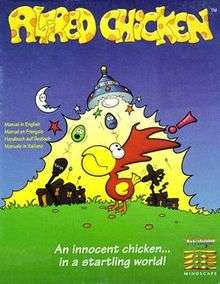Alfred Chicken
Alfred Chicken is a platform video game developed by Twilight and published by Mindscape. The game was released for Amiga, Amiga CD32, Game Boy, Nintendo Entertainment System, Super Nintendo Entertainment System in 1993 and February 1994, in Europe and North America, respectively. A Europe-exclusive remake of the game, entitled Alfred's Adventure, was developed by Möbius Entertainment and released by SCi for Game Boy Color in June 2000.[2] Another remake, named Alfred Chicken, was also developed by Monkey King, a division of Möbius Entertainment, and released by Sony Computer Entertainment for PlayStation in 2002.
| Alfred Chicken | |
|---|---|
 European Amiga cover art | |
| Developer(s) | Twilight |
| Publisher(s) | Mindscape |
| Designer(s) | Jason McGann Peter Tattersall |
| Composer(s) | David Whittaker Mark Knight (Amiga) |
| Platform(s) | Amiga, Amiga CD32, Game Boy, Game Boy Color, Nintendo Entertainment System, PlayStation, Super Nintendo Entertainment System |
| Release | GBC:
|
| Genre(s) | Platform |
| Mode(s) | Single-player |
Gameplay
The player takes the role of a chicken named Alfred who must find his way through bizarre levels full of balloons, telephones, cheese, and other strange elements. While he is on the ground, Alfred can walk, jump, and peck balloons and ground switches. While he is in the air he can dive bomb enemies or springs. Dive bombing enemies will destroy them. Dive bombing springs will bounce Alfred much higher so he can reach platforms well above his normal jumping ability. If he does not hit an enemy or a spring, Alfred will get stuck in the ground for a short time.
To complete a level, Alfred must find and peck all the balloons. The last balloon will take him to a boss fight. If Alfred dies, he starts as an egg located at the last balloon pecked. In Super Alfred Chicken for the Super Nintendo, finding the big balloon results in a Stage Clear.
Alfred can receive a few power-ups during the game. For one power-up, he must answer a telephone in secret areas to make Mr. Pekles (a giant flower) give him a pot of jam. The jam gives Alfred the ability to shoot a bomb (about the size of Alfred himself) which bounces around the screen collecting items and hurting enemies. Another power-up is a worm that spins around Alfred destroying enemies that it touches. The player must find a can of worms to get this power-up.
Release
The Game Boy game was the original version. Two revisions exist; the monochrome original, and a Super Game Boy version with a level select feature; the latter was developed by Hookstone and released by Sunsoft in Japan. The NES edition of the game is essentially a watered-down port of the Game Boy version. It features only 5 levels, which were originally in the Game Boy game. The Amiga version is the same as the Game Boy game and is identical except for its color graphics and increased screen resolution.
The game for the original PlayStation was released only in the PAL region. It features 2.5D action and is a brand-new game rather than a port. It was developed by Möbius Entertainment and released by Sony Computer Entertainment Europe in 2002.
Marketing
Karl Fitzhugh, the Product Manager of the Amiga version of the Alfred Chicken video game, ran as the Alfred Chicken Party candidate in the 1993 by-election in the Christchurch, Dorset constituency. The exercise was done to promote the original game's release. Fitzhugh finished second last with 18 votes, two votes ahead of the Rainbow Party candidate.[3]
The marketing attempt was partially successful. The Alfred Chicken Party was cited, along with other "frivolous or 'commercial' candidates", as a reason to increase the number of signatures required for an individual to be nominated as a political candidate at an election.[4]
There was also a toll-free number set up after the US release, which could be called to hear Alfred himself give a promotional speech about the game.
Reception
| Reception | ||||||||||||||||
|---|---|---|---|---|---|---|---|---|---|---|---|---|---|---|---|---|
| ||||||||||||||||
Electronic Gaming Monthly gave the Super NES version a 6.6 out of 10, calling it "a slow-moving game requiring more strategy than being able to run, jump and grab items! It takes a while to get into the swing of it, though."[6] They gave the NES version a 5 out of 10, explaining that it retains the large levels and good controls of the Super NES version, but that the drastically lower quality graphics and sounds make the game less enjoyable.[7] Reviewing the NES version, GamePro praised the challenging gameplay, the "cartoony" graphics, the "bouncy, loopy audio", and the "crisp controls", and determined the game to be a must-have for NES fans in light of how few games were being released for the system at that point.[8] On release, Famicom Tsūshin scored the Game Boy version of the game a 22 out of 40.[10] In Nintendo Power, the NES version was scored a three out of five. While they did like the big sizes of each level and occasionally comical graphics, they ultimately found it to be just another typical platformer.[9]
References
- "Alfred Chicken – PlayStation". IGN. Retrieved 2012-08-21.
- http://www.ign.com/articles/2000/05/23/alfreds-adventure
- British Parliamentary Election Results 1983-1997
- Parliament.uk - Memorandum by the Director of Campaigns and Elections of the Liberal Democrats
- Miller, Skyler. "Alfred Chicken - Review". AllGame. All Media Network. Archived from the original on November 15, 2014. Retrieved February 23, 2018.
- "Review Crew: Alfred Chicken (SNES)". Electronic Gaming Monthly. No. 54. EGM Media, LLC. January 1994. p. 42.
- "Review Crew: Alfred Chicken (NES)". Electronic Gaming Monthly. No. 56. EGM Media, LLC. March 1994. p. 42.
- LaMancha, Manny (May 1994). "ProReview: Alfred Chicken". GamePro. No. 58. IDG. p. 80.
- "Now Playing - Alfred Chicken". Nintendo Power. No. 127. Nintendo. February 1994. p. 106.
- NEW GAMES CROSS REVIEW: アルフレッドチキン. Weekly Famicom Tsūshin. No.345. Pg.32. 28 July 1995.
- Mindscape International Catalogue (PDF). Mindscape. 1993. p. 2.